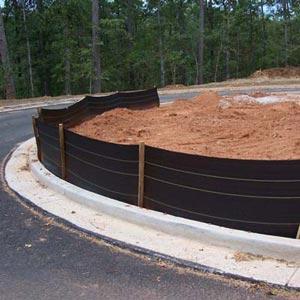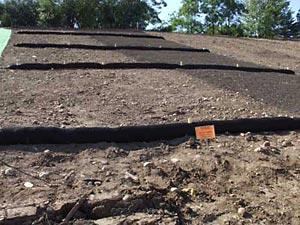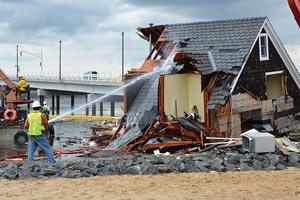Managing Stormwater and Dust at Demolition Sites
Stormwater and dust must be properly managed at a demolition site to reduce environmental impacts and comply with environmental regulations.
Stormwater

In carrying out demolition activities there is the potential for pollutants to be released from the site in stormwater runoff.
For example, if there is a rainstorm during the demolition, the rainwater may flow across the site and pick up sediment, building materials, trash or other substances. The rainwater can carry these pollutant-containing materials to the storm sewer system, which typically releases the stormwater to a nearby river, stream or lake.
Demolition activities and site controls should be planned to minimize the potential for pollutants to be released from the site in stormwater discharges. In certain cases it may be necessary to have a permit for stormwater discharges from a demolition project.
In general, if one or more acres of land will be "disturbed" as part of a project, and if runoff from the site drains to the local sewer system, it will be necessary to have permit coverage for the stormwater runoff from the project site(s).
Managing Your Environmental Responsibilities: A Planning Guide for Construction and Development (EPA-305-B-04-003, EPA Office of Compliance, April 2005) explains how to obtain permit coverage. Note that while much of the language in this resource relates to construction sites, the same principles and requirements apply to demolition sites where one or more acres of land is disturbed.
- In most cases you will need to file a short form with the permitting agency (typically the state environmental agency, in some cases US EPA).
- Under the provisions of the permit you will need to develop and implement a stormwater pollution prevention plan (SWPPP).
In the SWPPP you will plan measures (often referred to as best management practices or BMPs) to minimize the potential for pollutants to be released in the stormwater.
- EPA's Menu of Stormwater BMPs
- Construction Site Stormwater Runoff Control - many of these BMPs may be suitable for a demolition project:
- erosion control
- runoff control
- sediment control
- good housekeeping / materials management
Compost-based Best Management Practices (BMPs)

Three of these BMPs use compost-based technologies. These practices may be particularly well-suited for controlling erosion and sediment releases and helping establish vegetative cover.
- retains a large volume of water
- improves downstream water quality by retaining pollutants
- helps decompose trapped nutrients and hydrocarbons
- improves soil structure and nutrient content
Compost-based BMPs remove as much or more sediment from stormwater as traditional perimeter controls do.
In addition, creating demand for quality compost supports the development of food and yard waste composting capacity and jobs in the region.
- Compost Blankets (PDF) (6 pp, 887 K, About PDF) for erosion control
- Compost Filter Berms for sediment control
- Compost Filter Socks for sediment control
Dust

Regulatory requirements for the control of dust generated during demolition operations can arise from local ordinances or codes, county ordinances or codes, state regulations and some federal regulations.
Because these requirements are site specific, it is important that you work closely with local and state environmental regulators as well as with any office that issues a demolition permit (if you are in an area where such permits are required), to determine the requirements for the control of dust that exist in your area.
Even where no regulatory requirements may appear to exist, some permits or contracts may include provisions that require specific control measures for dust generated during demolition projects.
Fugitive dust is a serious concern for people who are especially sensitive or vulnerable to the effects of dust. Fugitive dust may also contain harmful amounts of lead. Lead in dust is the most common way people are exposed to lead.
